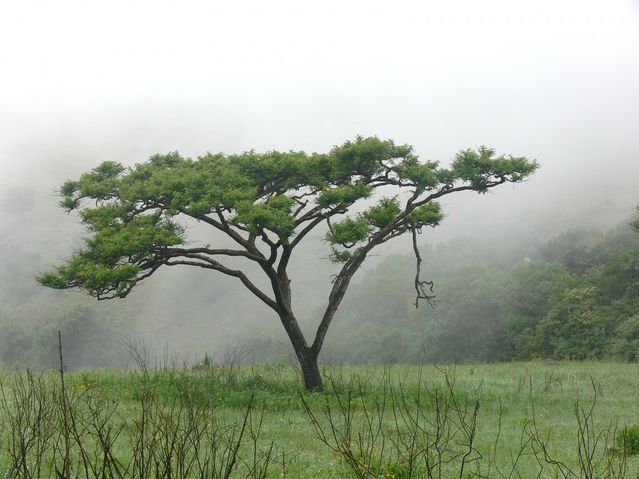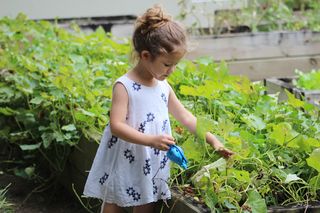Health
5 Ways Your Mental Health Depends on Beautiful Green Scenery
Deep down you need that tree, plant, and window in your life, research shows.
Posted June 10, 2019 Reviewed by Matt Huston

We are biased when it comes to landscapes and environmental aesthetics – we like trees, flowers, and green vistas more than dry, rocky lifeless environments. Where did these nearly universal preferences come from and what are the meaningful outcomes in our modern world?
Why are some landscapes more beautiful than others?
Our lives today are impacted by decisions our ancestors made generations ago on African savannas. During this time humans selected places to live, sought food and safety, and socialized in small hunter-gatherer groups. Through this process, specific likes and dislikes became wired in our brains, as the appropriate responses to the environment meant the difference between survival or death.
According to the savanna hypothesis, our current habitat preferences were shaped by evolutionary pressures in our ancestral past (Orians, 1980; Orians, 1986). Darwinian natural selection favored preferences, motivations and decision rules that attract us to resource-rich environments while avoiding environments populated with survival threats and lacking resources.
The powerful idea at the core of this argument is that many of our aesthetic preferences—from landscape beauty to food and entertainment—are the lingering result of natural selection, not arbitrary preferences for colors and shapes.
Here are five research findings on the connection between greenery and well-being.
1. Cross-cultural tree preferences
Support for the savanna hypothesis can be found in studies of landscape preferences. One such study asked subjects to rate a series of standardized photographs of trees taken in Kenya. Pictures were taken under similar daylight and weather conditions. Each photo focused on a single tree and varied along four dimensions – canopy shape, canopy density, trunk height, and branching pattern. Subjects from Australia, Argentina, and the United States all showed similar taste in the photos depicting trees. The trees that made a moderately dense canopy with trunks that separated in two near the ground–the savanna-like trees–were preferred by participants across the three cultures (Orians & Heerwagen, 1992).

2. Green vistas have a positive impact on patient recovery
Modern technology, structural designs, and construction materials allow us to comfortably inhabit climates that would have required intense effort just a few generations ago. Still, we carry with us the psychological preferences shaped by generations of ancestors living in a much different world and often customize our environments to resemble that ancient habitat. Most of us prefer physical spaces that offer views of green vistas rather than windowless basements. Looking at trees might even have a tangible health benefit: In one study, patients who viewed trees outside the window recovered more quickly from hospital stays (Ulrich, 1984). Flowers also appear to have a positive impact on hospital patients: Bringing flowers increased optimism and may have improved the rate of recovery (Watson & Burlingame, 1960).

3. Nature scenes reduce stress and diminish pain
The relationship between stress reduction and uncultivated outdoor settings grows more important as the rate of urbanization increases. When placed in uncertain and stressful situations, individuals who viewed pictures of nature scenery showed less physiological distress (Ulrich, 1986). Contact with vegetation need not be active, like gardening is, to provide health benefits. Passively viewing vegetation through a window can produce desirable effects as well. Studies in biophilic design demonstrate that people living and working in spaces with vegetation compared to those without vegetation show improved performance on mental tasks, more positive moods, greater ability to re-focus attention, stress reduction, and diminished perceptions of pain in health care settings (Kellert, Heewagen, & Mador, 2008). Research looking at over 900,000 data points found that children who grew up with the lowest levels of green space had a higher risk of developing a psychiatric disorder (Engemann, et al., 2019). The authors conclude that one long-term approach to improving mental health is to integrate natural environments into urban design.
4. Natural vs. artificial
Additional support for the savanna hypothesis comes from the body of evidence showing that humans often prefer natural environments over built environments (Kaplan & Kaplan, 1982). Using data from 30 studies, Kaplan (1992) summarized the results of participant ratings of photographed scenes of Western Australia, Egypt, Korea, British Columbia, and the United States. Across these varied geographic regions, participants preferred natural environments over built environments. Other data suggest that the addition of trees and vegetation increases positive evaluations of built environments, thus demonstrating the transformative power of foliage (Ulrich, 1983).

5. Landscape preferences show up in childhood
One of the earliest studies to test the idea that people have a generalized bias toward savanna-like environments hypothesized that “innate predispositions” for the savanna should be more likely to be revealed in children than in adults, given that adults have had greater opportunity to experience non-savanna ecosystems (Balling & Falk, 1982). In a study that included six age groups (8, 11, 15, 18, 35, and 70 or over), subjects were asked to rate photos from five natural biomes on scales that measured how much they would like to “live in” and “visit” each one. The researchers found that the youngest group (8-year-old children) preferred the savanna over the other habitats on both scales. The deciduous forest, coniferous forest, and savanna were equally liked among ages 15-70, with ratings for the desert and rainforest coming in lower at all ages. The study also implies that people have an aversion to drought conditions and arid landscapes. Photos depicting greener savanna were rated higher than similar savanna photos taken during the dry season. Finally, all age groups gave the lowest ratings to the desert environment (Balling & Falk, 1982).
Conclusion
In a broad sense, the savanna hypothesis addresses the issue of how we select places to live and why we find some landscapes more beautiful than others. The central argument is that our likes and dislikes in this domain were shaped over evolutionary time through the repeated selection of safe and healthy environments over dangerous and resource-poor landscapes.
References
Balling, J. D., & Falk, J. H. (1982). Development of visual preference for natural environments. Environment and Behavior, 14(1), 5-28.
Bennett, K., Gualtieri, T., & Kazmierczyk, B. (2018). Undoing solitary urban design: A review of risk factors and mental health outcomes associated with living in social isolation. Journal of Urban Design and Mental Health, 4:7.
Kaplan, S. (1992). Environmental preference in a knowledge-seeking, knowledge-using organism. In J. H. Barkow, L. Cosmides, & J. Tooby (Eds.), The adapted mind: Evolutionary psychology and the generation of culture. New York: University Press.
Kaplan, S. & Kaplan, R. (1982). Cognition and environment: Functioning in an uncertain world. New York: Praeger.
Kellert, S. R., Heerwagen, J., & Mador, M. (2008). Biophilic design: The theory, science, and practice of bringing buildings to life. Hoboken, N.J: Wiley.
Orians, G. (1980). Habitat selection: General theory and applications to human behavior. In J. S. Lockard (Ed.), The evolution of human social behavior (pp. 49-66). Chicago: Elsevier.
Orians, G. (1986). An ecological and evolutionary approach to landscape aesthetics. In E.C Penning-Rowsell & D. Lowenthal (Eds.), Landscape meaning and values (pp.3-25). London: Allen & Unwin.
Orians, G. & Heerwagen, J. H. (1992). Evolved responses to landscapes. In J. H. Barkow, L. Cosmides, & J. Tooby (Eds.), The adapted mind: Evolutionary psychology and the generation of culture. New York: University Press.
Ulrich, R.S. (1983). Aesthetic and affective response to natural environment. In I. Altman & J. Wohlwill (Eds.), Human behavior and environment, Vo1.6: Behavior and natural environment. New York: Plenum, 85-1 25.
Ulrich, R. S. (1984). View through a window may influence recovery from surgery. Science, 224(4647), 420-421. doi:10.1126/science.6143402
Ulrich, R. S. (1986). Human responses to vegetation and landscapes. Landscape and Urban Planning, 13, 29-44. doi:10.1016/0169-2046(86)90005-8
Watson, D. P., & Burlingame, A. W. (1960). Therapy through horticulture. New York: Macmillan.




